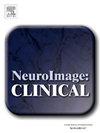Precision targeting of right dorsolateral prefrontal cortex with neuronavigated rTMS alleviates chronic insomnia via functional connectivity reorganization: a randomized neuroimaging trial
IF 3.4
2区 医学
Q2 NEUROIMAGING
引用次数: 0
Abstract
Background
Repetitive transcranial magnetic stimulation (rTMS) offers a promising approach for the treatment of insomnia; however, the precise targets and underlying neural mechanisms remain unclear. This randomized, wait-controlled trial aimed to evaluate the clinical efficacy of neuronavigated rTMS targeting the right dorsolateral prefrontal cortex (DLPFC) in chronic insomnia disorder (CID) and to identify potential neural mechanisms associated with therapeutic outcomes.
Methods
Fifty patients with CID were randomized to receive 20 sessions of 1 Hz rTMS targeting the right DLPFC or to a waitlist control group. Stimulation coordinates were selected (MNI: 40,39,11) based on our previous neuroimaging meta-analysis, and were precisely localized using MRI-guided neuronavigation. Clinical assessments and resting-state fMRI were conducted before and after the intervention, respectively. Target-based functional connectivity (FC) analysis was used to map rTMS-associated network changes, while causal mediation analysis was used to examine the relationships between neural changes and clinical improvements.
Results
Compared to waitlist controls, the rTMS group showed greater improvements in insomnia and mood symptoms (all p < 0.001), with higher response rates (54.55 % vs. 9.09 %) and remission rates (68.18 % vs. 13.64 %). FC analysis showed significant group × time effects on the bilateral DLPFC, middle cingulate cortex, and right anterior cerebellar vermis. Mediation analysis indicated that FC changes in the right DLPFC mediated 24 % of the improvement in insomnia severity (Insomnia Severity Index, p = 0.048).
Conclusion
These preliminary findings suggest that precision neuronavigated rTMS targeting the right DLPFC may alleviate insomnia symptoms, with the observed clinical improvements potentially related to the reorganization of the DLPFC network. While these results are encouraging, further research based on placebo-controlled study designs is required to confirm these effects and better understand the underlying mechanisms. This study provides preliminary evidence supporting the integration of precision targeting with neuroimaging to explore the mechanisms underlying the effects of rTMS in insomnia treatment.
神经导航rTMS精确定位右背外侧前额叶皮层通过功能连接重组缓解慢性失眠:一项随机神经影像学试验
背景重复经颅磁刺激(rTMS)为治疗失眠提供了一种很有前途的方法;然而,确切的目标和潜在的神经机制尚不清楚。这项随机、等待对照试验旨在评估针对右背外侧前额叶皮层(DLPFC)的神经导航rTMS治疗慢性失眠症(CID)的临床疗效,并确定与治疗结果相关的潜在神经机制。方法50例CID患者随机接受20次针对右侧DLPFC的1 Hz rTMS治疗或进入等待名单对照组。根据我们之前的神经影像学荟萃分析选择刺激坐标(MNI: 40,39,11),并使用mri引导的神经导航精确定位。干预前后分别进行临床评估和静息状态功能磁共振成像(fMRI)。采用基于目标的功能连通性(FC)分析来绘制rtms相关的网络变化,而因果中介分析则用于研究神经变化与临床改善之间的关系。结果与等候名单对照组相比,rTMS组在失眠和情绪症状方面表现出更大的改善(p <;0.001),有效率(54.55%比9.09%)和缓解率(68.18%比13.64%)更高。FC分析显示双侧DLPFC、中扣带皮层和右侧小脑前蚓部有显著的组×时间效应。中介分析表明,右DLPFC的FC改变介导了24%的失眠严重程度的改善(失眠严重程度指数,p = 0.048)。结论针对右侧DLPFC的精确神经导航rTMS可能减轻失眠症状,其临床改善可能与DLPFC网络的重组有关。虽然这些结果令人鼓舞,但需要基于安慰剂对照研究设计的进一步研究来证实这些效果并更好地了解潜在机制。本研究提供了初步证据,支持将精确靶向与神经影像学相结合,探索rTMS治疗失眠的作用机制。
本文章由计算机程序翻译,如有差异,请以英文原文为准。
求助全文
约1分钟内获得全文
求助全文
来源期刊

Neuroimage-Clinical
NEUROIMAGING-
CiteScore
7.50
自引率
4.80%
发文量
368
审稿时长
52 days
期刊介绍:
NeuroImage: Clinical, a journal of diseases, disorders and syndromes involving the Nervous System, provides a vehicle for communicating important advances in the study of abnormal structure-function relationships of the human nervous system based on imaging.
The focus of NeuroImage: Clinical is on defining changes to the brain associated with primary neurologic and psychiatric diseases and disorders of the nervous system as well as behavioral syndromes and developmental conditions. The main criterion for judging papers is the extent of scientific advancement in the understanding of the pathophysiologic mechanisms of diseases and disorders, in identification of functional models that link clinical signs and symptoms with brain function and in the creation of image based tools applicable to a broad range of clinical needs including diagnosis, monitoring and tracking of illness, predicting therapeutic response and development of new treatments. Papers dealing with structure and function in animal models will also be considered if they reveal mechanisms that can be readily translated to human conditions.
 求助内容:
求助内容: 应助结果提醒方式:
应助结果提醒方式:


